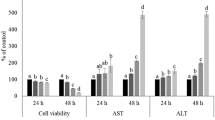Abstract
The hepatoprotective activity of lactic acid bacteria (Lactobacillus brevis HY7401,Lactobacillus acidophilus CSG andBifidobacterium longum HY8001), which inhibited β-glucuronidase productivity of intestinal microflora, ont-BHP- or CCI4-induced hepatotoxicity of mice were evaluated. These oral administration of lactic acid bacteria lowered β-glucuronidase production of intestinal microflora as well asEscherichia coli HGU-3. When lactic acid bacteria at a dose of 0.5 or 2 g (wet weight)/kg was orally administered on CCI4-induced liver injury in mice, these bacteria significantly inhibited the increase of plasma alanine transferase and aspartate transferase activities by 17∼57% and 57∼66% of the CCI4 control group, respectively. These lactic acid bacteria also showed the potent hepatoprotective effect againstt-BHP-induced liver injury in mice. The inhibitory effects of these lactic acid bacteria were more potent than that of dimethyl diphenyl bicarboxylate (DDB), which have been used as a commercial hepatoprotective agent. Among these lactic acid bacteria,L. acidophilus CSG exhibited the most potent hepatoprotective effect. Based on these findings, we insist that an inhibitor of β-glucuronidase production in intestine, such as lactic acid bacteria, may be hepatoprotective.
Similar content being viewed by others
REFERENCES
Dutton, G. J., Glucuronidation of drugs and other compounds. CRC press, Florida pp. 1–42 (1980).
Goldin, B. and Gorbach, S. L., The relationship between diet and rat fecal bacterial enzymes implicated in colon cancer.J. Natl. Cancer Ints., 57, 371–375 (1976).
Hill, M. J. and Crowther, J. S., Bacteria and bacteriology of colonic polyp patients and control patients.Cancer Res., 35, 3407–3417 (1975)
Kinoshita, N. and Gelvoin, H.V., β-Glucuronidase catalyzed hydrolysis of benzo[a]pyrene-3-glucuronide and binding to DNA.Science, 199, 307–309 (1978).
Kim, D.-H., Kang, H.-J., Park, S.-H., and Kobashi, K., Characterization of β-glucuronidase and β-glucosidase of alkalotolerant intestinal bacteria.Biol. Pharm, Bull., 17, 423–425 (1994)
Kim, D.-H., Lee, J. H., Bae, E. A., and Han, M. J., Induction and inhibition of indole production of intestinal bacterial.Arch. Pharm. Res., 18, 351–355 (1995a).
Kim, D.-H., Jang, I. S., Park, J. B., and Lee, S. W., Protective role of mushrooms in experimental colon carcinogenesis.Arch. Pharm. Res., 18, 79–83 (1995b).
Kim, D.-H., Jin, Y. H., Jung, E. A., Han, M. J., and Kobashi, K., Purification and characterization of β-glucuronidase fromE. coli HGU-3, a human intestinal bacterium.Biol. Pharm. Bull., 18, 1184–1188 (1995c).
Levy, G. A., Kerr, L. M. H., and Campbell, J. C., β-Glucuronidase and cell proliferation.Biochem. J., 42, 462–468 (1948).
Mills, G. T. and Smith, E. E. B., The β-glucuronidase activity of chemically induced rat hepatoma.Science, 114, 690–692 (1951).
Mills, G. T., Paul, J., and Smith, E. E. B., Studies in β-glucuronidase, the influence of age, partial hepatectomy and other factors in the β-glucuronidase activity in rate liver.Biochem. J., 53, 232–245 (1953).
Kim, D.-H., Jin, Y.-H., Park, J.-B., and Kobashi, K., Silymarin and its components are inhibitors of β-glucuronidase.Biol. Pharm. Bull., 17, 443–445 (1994).
Shim, S. B., Kim, N. J., and Kim, D.-H., β-Glucuronidase inhibitory activity and hepatoprotective effect of 18β-glycrrhetinic acid from the rhizomes ofGlycyrrhiza uralensis.Plant Med., 66, 40–43 (2000).
Stahl, P. D., and Fishman, W. H., β-Glucuronidase In Bergmeyer, H. U. (ed). Method of Enzymatic Analysis. Verlag Chemie GmbH, Weinheim. 4, pp 246–256 (1983).
Pineda, E. P., Goldberg, J. A., Banks, B. M., and Rutenburg, A. M., The significance of serum β-glucuronidase activity in patients with liver disease.Gastroenterology, 36, 202–213 (1959).
Reitman, S. and Frankel, S., A colorimetric method for the determination of serum glutamic oxaloacetic and glutamic pyruvic transaminase.Am. J. Clin. Path., 28, 56–63 (1957).
Wang, W. L., Clinical effect of DDB piles on 56 cases of chronic viral hepatitis B.New Drugs Clinic, 3, 13–15 (1984).
Weiburger, J. H., Reddy, B. S., and Wynder, E. L., Colon cancer: its epidemiology and experimental production.Cancer, 40, 2414–2420 (1977).
Author information
Authors and Affiliations
Corresponding author
Rights and permissions
About this article
Cite this article
Han, SY., Huh, CS., Ahn, YT. et al. Hepatoprotective effect of lactic acid bacteria, inhibitors of β-glucuronidase production against intestinal microflora. Arch Pharm Res 28, 325–329 (2005). https://doi.org/10.1007/BF02977800
Received:
Issue Date:
DOI: https://doi.org/10.1007/BF02977800




